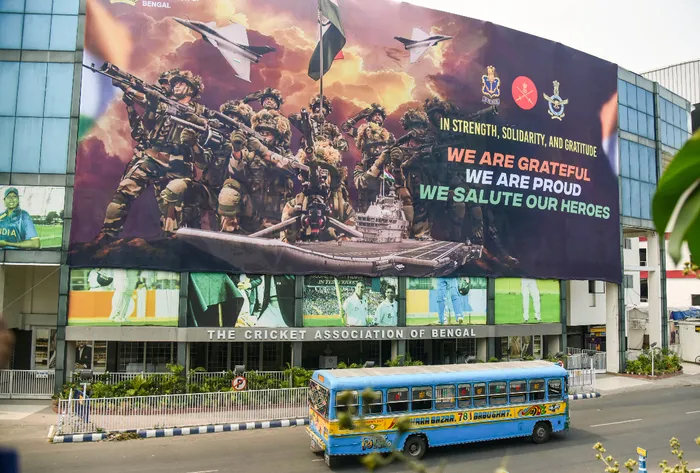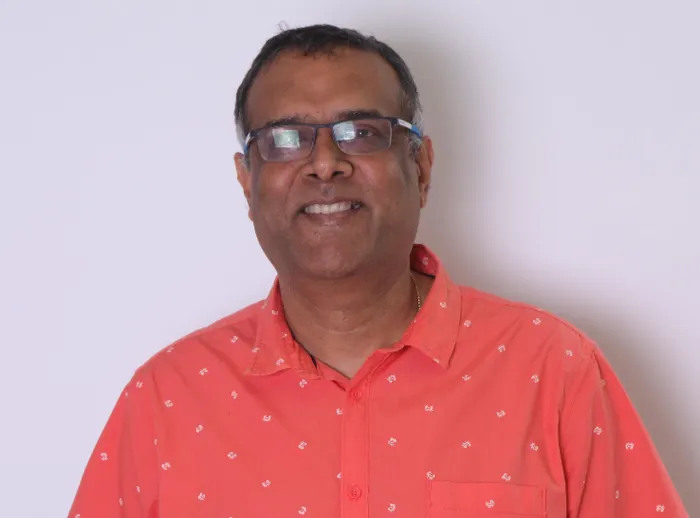India has risen: why the colonial powers fear New India in 2025?
How India silenced Pakistan after the Pahalgam terrorist attack

A banner is displayed in front of Eden Gardens, Kolkata, to honour the Indian Army, The banner was organised by the Cricket Association of Bengal after ‘Operation Sindoor’.
Image: Kuntal Chakrabarty / IANS
In 2025, India is no longer rising. India has risen because of Sanathan Dharma. (SriAurobindo in his famous Uttarpara Speech – Alipore Jail)
How India silenced Pakistan after the Pahalgam terrorist attack
The terrorist attack in Pahalgam sent shockwaves through India. As the nation mourned the loss of innocent lives, the world waited to see how New India would respond. What followed was not just a counter-response - it was a calculated message to both Pakistan and the international community: India will not tolerate terrorism, and it will not stay silent.
Swift intelligence operations
Within hours of the attack, Indian intelligence agencies identified the handlers and routes involved. The response was surgical - targeted strikes on launchpads across the Line of Control, using precision-guided munitions. The Indian Army neutralized key operatives without escalating into full-scale conflict, demonstrating capability and restraint in equal measure.
Diplomatic exposure of Pakistan
India wasted no time in launching a diplomatic offensive. At the UN and other global platforms, Indian diplomats presented concrete evidence linking the attack to Pakistan-based terror networks. High-resolution satellite imagery, intercepted communications, and intelligence inputs were shared with key allies, exposing Pakistan’s continued support for cross-border terrorism. Countries that once offered Pakistan diplomatic cover were forced into silence, as global sympathy shifted toward India’s right to self-defence.
Economic pressure campaign
India turned up the heat economically. It pushed for FATF (Financial Action Task Force) action, reinforcing Pakistan’s grey listing by highlighting its failure to crackdown on terror financing. Trade privileges were reviewed, cross-border water-sharing discussions paused, and Indian influence was used to stall international aid and loans to Pakistan from multilateral institutions. The message was clear: Terrorism will come at a cost.
Narrative control and media strategy
India also controlled the narrative with clarity and confidence. Major media outlets were briefed with verified information. The global press covered India’s calibrated response, while Pakistan found itself on the back foot - issuing denials with little credibility left. Quietly, without fanfare or confrontation, India has transformed into a strategic, economic, technological, and cultural force that can no longer be side lined. While Western media remains largely muted and politicians hesitate to acknowledge it publicly, internal reports and elite summits in the West tell a different story - one of concern, caution, and yes, even fear.
Diplomacy rewritten: strategic autonomy
India is mastering the geopolitical chessboard. It buys oil from Russia, partners with the US, builds ports with Iran, supports Palestine, strengthens ties with Israel, and maintains a delicate dialogue with China. This isn't indecision. It's strategic autonomy - refusing to be boxed into ideological alliances or Western expectations. India doesn’t follow; it leads. Its refusal to blindly align during the Russia-Ukraine conflict shocked the West, proving India is a diplomatic force unto itself.
Military might: self-reliant and strategic
India is now one of the world’s top military powers - not just by troop count, but through modernization. Indigenous missiles, stealth jets, nuclear submarines, and space defence systems are all part of the Atmanirbhar Bharat (self-reliant India)vision. India is no longer an arms importer; it’s becoming an exporter. And with control over crucial sea lanes and satellite systems, it has become a formidable force in multi-domain warfare.
India’s retaliation: how the BrahMos Missile silenced Pakistan’s threats
India faced a familiar adversary - cross-border terrorism, rooted in Pakistani soil. Butun like in the past, India’s response was neither delayed nor diplomatic. This time, it was precise, powerful, and unmistakably modern. At the heart of this response was one of India’s most formidable weapons: the BrahMos supersonic cruise missile.
Developed jointly by India and Russia, the BrahMos missile is the world's fastest supersonic cruise missile. With speeds reaching Mach 2. 8 to Mach 3 and the ability to fly at low altitudes, it is virtually impossible to intercept. Its pinpoint accuracy and deep-strike capability make it a tactical nightmare for enemy infrastructure.
In the context of the Pahalgam retaliation, India used BrahMos to target select Pakistani military airfields believed to be either staging grounds or logistic hubs for terror-support operations across the LoC. Precision-guided BrahMos missiles were launched from mobile land-based platforms deep within Indian territory.
Within minutes, runways, control towers, and hangars suspected of housing combat drones and radar systems were obliterated. Pakistani air defence systems, caught off guard, failed to intercept the ultra-fast cruise missiles, leading to widespread damage and operational paralysis.
These strikes were not designed to escalate to full-scale war—but to send a crystal-clear message: India will destroy terror infrastructure wherever it hides, and with absolute impunity. Pakistan's Muted Response. Unlike past incidents, Pakistan chose an unusually subdued tone post-strike. The damage was undeniable.
Satellite imagery and open-source intelligence later confirmed smoke plumes, scorched runways, and heavy military movement in the aftermath. Global media caught on, but Pakistan’s official line remained evasive - unable to admit vulnerability, yet incapable of denying the impact. This silence was more telling than words. Shocked by theses attacks, the DGMO of Pakistan called the DGMO in India to stop the attack after 11 airfields were destroyed.
Western Nations and China were shell shocked as the Richter scale showed the earth being moved in some parts of Pakistan. The use of BrahMos missiles signals a paradigm shift in India’s counterterrorism doctrine. Precision strikes using high-tech, domestically produced weapons now replace prolonged diplomatic processes. India has the technological edge in the region. India will strike without crossing political red lines, using long-range precision assets. India does not seek war, but it will no longer absorb pain silently.
Strategic geography: the gatekeeper of Asia
India’s location gives it unmatched geopolitical leverage - overseeing vital sea routes, internet cables, and trade corridors. With port partnerships and infrastructure projects in key regions, India is no longer just a participant in Asian geopolitics; it’s the gatekeeper. To access Asia, counter China, or trade with the Gulf - you need India.
A post-Western power and being bullied
The West’s anxiety isn't just about India's growing power - it’s about what that power represents: a world order that no longer centres on Western approval. India is democratic, diverse, and increasingly self-reliant making it more unpredictable and, in many ways, more threatening to the old guard than even authoritarian rivals. And the world has no choice but to take it seriously. Gone are the days when terror from across the border was met with hesitation.
New India responds with strength, strategy, and global support. By silencing Pakistan diplomatically, militarily, and economically after the Pahalgam attack, India showcased a model of modern counterterrorism - measured, credible, and unyielding.
This isn’t escalation. Despite a deceptive or fake ceasefire that was violated by Pakistan, the moral high ground of India in defending its borders and 1.4 billion people puts itself in the ethical realms of civilisation that the West tried to destroy through its colonisation and slavery. This is evolution.

Pradeep Ramlall
Image: Supplied
Pradeep Ramlall is the secretary of the Hindusa Seva Foundation.
** The views expressed do not necessarily reflect the views of IOL or Independent Media.